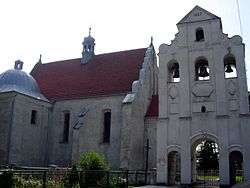Opatowiec
Opatowiec [ɔpaˈtɔvjɛt͡s] is a town in Kazimierza County, Świętokrzyskie Voivodeship, in south-central Poland. It is the seat of the gmina (administrative district) called Gmina Opatowiec. It lies in Lesser Poland, on the left bank of the Vistula (opposite the confluence of the Dunajec), approximately 18 kilometres (11 mi) east of Kazimierza Wielka and 73 km (45 mi) south of the regional capital Kielce.[1] In 2006 the village had a population of 410.
Opatowiec | |
|---|---|
Town | |
 Saint James Church | |
 Coat of arms | |
 Opatowiec | |
| Coordinates: 50°14′N 20°43′E | |
| Country | |
| Voivodeship | Świętokrzyskie |
| County | Kazimierza |
| Gmina | Opatowiec |
| Government | |
| • Mayor | Alfred Minior |
| Elevation | 200 m (700 ft) |
| Population (2006) | |
| • Total | 410 |
| Time zone | UTC+1 (CET) |
| • Summer (DST) | UTC+2 (CEST) |
| Postal code | 28-520 |
| Area code(s) | +48 41 |
| Vehicle registration | TKA |
| Website | www |
Opatowiec has a rich and long history. It was granted town charter as early as 1271, and stripped of it by Russian authorities in 1869. The village is located on National Road Nr. 79 (Warsaw - Bytom). Local points of interest include a 15th-century Dominican church, and a monument to Józef Piłsudski next to the Vistula river.
The village of Opatowiec was first mentioned in 1085, when Judyta, the wife of Prince Władysław I Herman, presented it to the Benedictine Abbey from Tyniec. In 1271, Prince Boleslaw V the Chaste granted Opatowiec Magdeburg rights town charter, upon request of abbot Modlibob. The town became a local trade center, due to its location along the Vistula waterway, and on a merchant road from Silesia to Kievan Rus. In 1283, abbot Tomasz from Tyniec founded here a Dominican Order abbey, and in 1341, King Kazimierz Wielki granted Opatowiec the right to organize fairs. In the mid-14th century, Opatowiec had almost 1,500 inhabitants. Here, in 1474, a congress of Lesser Poland’s szlachta took place, during which war with Hungarian king Matthias Corvinus was discussed. In the same year, King Kazimierz Jagiellończyk hosted at Opatowiec envoys from the Republic of Venice, to discuss war with the Ottoman Empire. By 1500, Opatowiec had a parish church, bath houses, hospital and several guilds. In 1579, it had 55 different workshops, and four mills. For centuries, the town belonged to Wiślica County of Lesser Poland's Sandomierz Voivodeship.
Like almost all municipal centers of Lesser Poland, the town was completely destroyed by Swedish soldiers in the Deluge (1655 - 1660). In 1772, when after the first partition of Poland, the Tyniec abbey became part of Austrian Galicia, Opatowiec changed hands and became the property of the government. Soon afterwards, it was purchased by the Walewski family. In 1815, the town was part of Russian-controlled Congress Poland, and began to lose its importance. By 1862, it had only 459 residents and 67 houses. In 1869, as a punishment for January Uprising, it was stripped of its town charter and became a village. Opatowiec was destroyed in World War I, further destruction was brought by World War II. In September 1939, the village was burned by the Wehrmacht, on Sept. 8, 1939, German soldiers shot here 45 Polish prisoners of war. On July 28, 1944, a skirmish took place here between a local Home Army unit and the Russian Liberation Army. As a result, the village was completely burned, and 31 persons were murdered, including children.
It regained its urban status on 1 January 2019, becoming the smallest town in Poland, with only 338 inhabitants.
 Landscape Opatowiec surroundings |
 River Wisła in Opatowiec |
References
| Wikimedia Commons has media related to Opatowiec. |